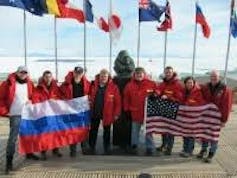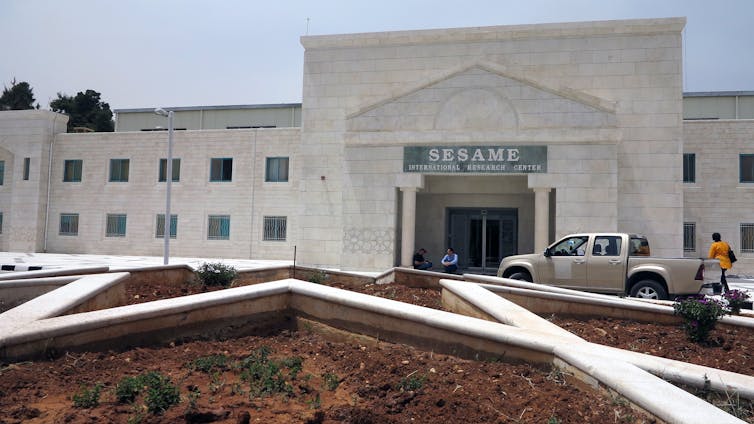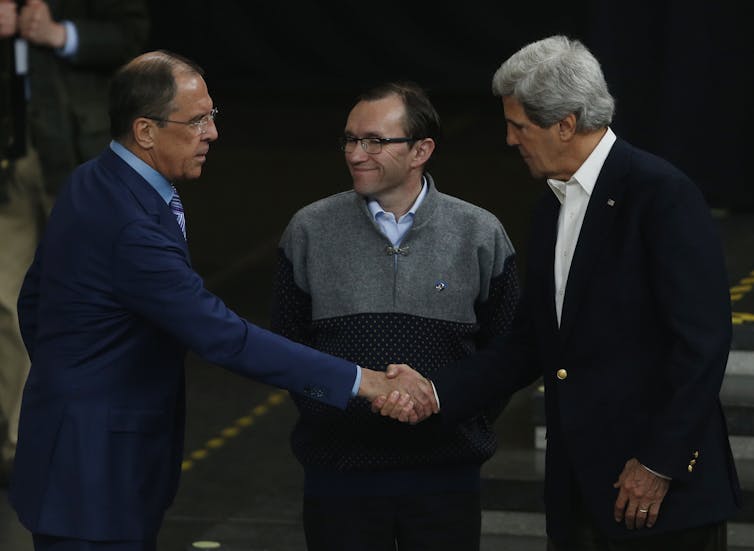Could science diplomacy be the key to stabilizing international relations?
- Written by Paul Arthur Berkman, Director of the Science Diplomacy Center and Professor of Practice in Science Diplomacy at the Fletcher School of Law and Diplomacy, Tufts University
It’s no secret that United States–Russia relations are currently rife with tension and mistrust. The news is full of reports of Russia meddling in U.S. elections, seeding U.S. media with fake news, supporting the Syrian regime and so on.
The relationship between the two countries has reached an all-time low since the fall of the Soviet Union, with some going so far as to call it[1] a new “cold war.”[2] Diplomats have been unable to mend the relationship, as national security interests on each side are too narrow to provide common ground.
But there are avenues of collaboration beyond the security realm that can help to balance strained relationships, maintain open channels of communication and build trust, enabling a more positive diplomatic process overall.
One key avenue is science. As a common and apolitical language, science brings allies and adversaries together with technology and innovation to address cross-border challenges that exist across the Earth – think climate, disease pandemics and international trade – which are out of reach for a single nation to address alone.
 Collaboration at the bottom of the world.
U.S. State Department, CC BY[3][4]
Collaboration at the bottom of the world.
U.S. State Department, CC BY[3][4]
Since the 1950s, the U.S. and Russia have been cooperating continuously in a four specific international spaces[5] – the high seas, Antarctica, outer space and deep sea – and the mechanism for cooperation has consistently been science. For instance, they cooperate on the 1959 Antarctic Treaty[6], which preserves the continent for peaceful purposes as the first nuclear arms agreement with scientific research as the basis for international cooperation. Similarly, in space, collaboration between the U.S. and the Soviet Union on the Apollo-Soyuz Test Project in 1975 led to the design of an international docking system, creating a physical bridge for subsequent operations and joint experiments that we see with the International Space Station[7] today.
The term “science diplomacy” is recently coined, with the first book in this new field[8] emerging from the 2009 Antarctic Treaty Summit[9]. But this diplomatic approach has long existed in practice. As both an academic who studies science diplomacy[10] and a practitioner who implements it, I suggest that science can help bridge contemporary political differences between the superpowers as well as other actors, promoting cooperation and preventing conflict across the world.
A different avenue for diplomacy
People usually think of diplomacy as how states represent themselves and negotiate to advance their own interests. These are the fraught high-level talks between nations that are featured on newspapers’ front pages. Diplomats on each side angle and negotiate to come out on top of a particular issue with political expediency. Picture the sit-down in Singapore between President Trump and North Korea’s Kim Jong Un.
 The agreement between Kim Jong Un and Donald Trump will require continuity between the present and future, independent of political posturing – which science can help provide.
AP Photo/Evan Vucci[11]
The agreement between Kim Jong Un and Donald Trump will require continuity between the present and future, independent of political posturing – which science can help provide.
AP Photo/Evan Vucci[11]
Science diplomacy is different, operating across a continuum of urgencies from political to sustainability time scales. Nations are still coming together to discuss and resolve cross-border issues. But what’s on the table revolves around common interests revealed across generations by science – including natural sciences and social sciences as well as indigenous knowledge – providing a foundation for negotiation that is far less politically charged and divisive to discuss and resolve the topics of the day.
For example, countries came together to share resources and design a joint response to two recent pandemics: Zika in Latin America[12] and Ebola in West Africa[13]. Following the easing of U.S.-Cuba relations in December 2014, scientists from the two countries began to collaborate on cancer research[14].
Science diplomacy also supports economic prosperity, balancing environmental protection and societal well-being through innovation. Countries are sharing and collaborating on technologies that will help transition resource-based economies to knowledge-based economies. This kind of cooperation can yield poverty-alleviating solutions along with progress across a suite of sustainable development goals[15].
Science diplomacy is also about contributing to informed decision-making by sharing evidence and options, without advocacy. This kind of exchange helps ensure the diplomatic process is objective and inclusive, relying on our leaders to make decisions that have legacy value. Imagine if a group of diplomats got together in a negotiating room to assess and design a response to a pandemic without consulting and involving medical and public health experts. It wouldn’t make sense. The recent Iran nuclear deal[16], for instance, relied on scientists’ expertise to build common interests among nations as the prelude for an agreement, providing an ongoing basis for cooperation despite political variability.
 The SESAME center in Jordan aims to network staff with other global research facilities, thus enabling possibilities for scientific exchanges.
IAEA Imagebank, CC BY[17][18]
The SESAME center in Jordan aims to network staff with other global research facilities, thus enabling possibilities for scientific exchanges.
IAEA Imagebank, CC BY[17][18]
Collaboration between scientists from different countries can help create pathways for working together on controversial issues, more generally. For example, SESAME[19] is the Middle East’s first major international research center. It’s designed to host both Israeli and Palestinian scientists. Instead of career diplomats and statesmen focused on pushing national agendas, researchers and practitioners with particular scientific expertise are focusing on research to address shared questions, divorced from politics. The CERN[20] particle accelerators in Europe have demonstrated the value of this kind of scientific collaboration among nations since the 1950s.
And with cooperation and trust among scientists from diverse nations, there can be a ripple effect of goodwill between the nations involved, including agreements that would otherwise be difficult or impossible to negotiate at the time with any hope of continuity.
An Arctic environment example
My own involvement with U.S.-Russia relations started with chairing the first formal dialogue between NATO and Russia regarding environmental security in the Arctic Ocean[21]. This 2010 dialogue at the University of Cambridge was funded by NATO along with other organizations and co-directed with the Moscow State Institute of International Relations. It involved four Russian ministries with representative to the president of Russia as well as experts and senior diplomats from 16 other nations.
As academics, my Russian colleagues and I were able to create an apolitical platform for a conversation that had never taken place. Matters related to military security[22] had otherwise prevented open consideration of strategies to promote cooperation and prevent conflict[23] around the North Pole, which remains a region of significant strategic interest with nuclear submarines. Here, science diplomacy brought together two long-estranged actors to productively address a security issue of common interest to both.
 Russia’s Foreign Minister Sergey Lavrov and U.S. Secretary of State John Kerry share a handshake at a 2013 Arctic Council Ministerial Meeting.
AP Photo/Charles Dharapak[24]
Russia’s Foreign Minister Sergey Lavrov and U.S. Secretary of State John Kerry share a handshake at a 2013 Arctic Council Ministerial Meeting.
AP Photo/Charles Dharapak[24]
Since 2009, and despite ongoing diplomatic tensions, the U.S. and Russia have co-chaired three task forces under the auspices of the Arctic Council, the region’s intergovernmental forum for sustainable development and environmental protection. And they’ve successfully led to three binding legal agreements[25] among all eight Arctic states: Canada, Denmark, Finland, Iceland, Norway and Sweden, along with Russia and the U.S.
The most recent agreement just came into force in May 2018 to enhance international Arctic scientific cooperation[26]. It reflects an understanding among these nations: International scientific collaboration is essential to pursue sustainable solutions, transcending national interests to maintain peace, stability and constructive cooperation in the Arctic. Science diplomacy offers a route that works both politically and practically[27].
International agreements, without politics
Science is a neutral platform that allows for less politically charged dialogues, which in turn create bridges that help overall diplomatic efforts.
Over the years, science diplomacy has helped build common ground and peacefully manage international spaces, as well as achieve technological breakthroughs that have global relevance, from health care to the digital revolution. There is every reason for science to continue helping to maintain important channels of communication in the face of current tensions and all yet to come.
For today’s globally interconnected and growing civilization, which is confronting rapid transformation on the back of advances in science, technology and innovation, science diplomacy offers a unique process to build our common future[28].
References
- ^ as to call it (www.bbc.com)
- ^ new “cold war.” (www.foreignaffairs.com)
- ^ U.S. State Department (www.state.gov)
- ^ CC BY (creativecommons.org)
- ^ international spaces (doi.org)
- ^ Antarctic Treaty (www.ats.aq)
- ^ International Space Station (www.nasa.gov)
- ^ first book in this new field (repository.si.edu)
- ^ Antarctic Treaty Summit (www.atsummit50.org)
- ^ As both an academic who studies science diplomacy (sites.tufts.edu)
- ^ AP Photo/Evan Vucci (www.apimages.com)
- ^ Zika in Latin America (zikaplan.tghn.org)
- ^ Ebola in West Africa (www.who.int)
- ^ collaborate on cancer research (www.miamiherald.com)
- ^ sustainable development goals (www.un.org)
- ^ Iran nuclear deal (www.businessinsider.com)
- ^ IAEA Imagebank (www.flickr.com)
- ^ CC BY (creativecommons.org)
- ^ SESAME (www.sesame.org.jo)
- ^ CERN (home.cern)
- ^ environmental security in the Arctic Ocean (www.springer.com)
- ^ Matters related to military security (oaarchive.arctic-council.org)
- ^ to promote cooperation and prevent conflict (www.routledge.com)
- ^ AP Photo/Charles Dharapak (www.apimages.com)
- ^ three binding legal agreements (www.arctic-council.org)
- ^ enhance international Arctic scientific cooperation (www.state.gov)
- ^ Science diplomacy offers a route that works both politically and practically (doi.org)
- ^ our common future (www.un-documents.net)
Authors: Paul Arthur Berkman, Director of the Science Diplomacy Center and Professor of Practice in Science Diplomacy at the Fletcher School of Law and Diplomacy, Tufts University

